Each apple is a flower that has known love. - Félix Leclerc
The apple is as old as time. I mean, just read your Bible, right? Or your Greek mythology. Funny how the apple took on a life of its own so many, many centuries ago, a life fraught with ignominy and disrepute. Eris, the Goddess of Discord, tossed an apple into a party she had not been invited to in order to cause chaos, animosity, and rivalry, her little stunt eventually leading to the Trojan War and untold destruction. Eve offered the forbidden fruit to tempt Adam; when he bit into the apple, his eyes were opened to the knowledge of Good and Evil, getting him banned from Paradise and causing the downfall of man and woman, leading to suffering of every known sinful desire. Not a very good beginning for such a sweet and prolific fruit. Oddly enough, “pomme” - the word for apple which first appeared in written French in 1080 in the Song of Roland, which came from the Latin word poma meaning fruit - replaced the word malum, the Latin word for bad or evil, leading us back to the root of the apple as being a symbol of sin, discord, and quite possibly debauchery.
Lucky for us, the apple redeemed itself somewhere over the course of the centuries.
There is proof of the existence of apple trees on earth as early as 80 million years ago somewhere along the Chinese border. Neolithic man apparently carried the apple and the seeds across the continents to Europe about 1.6 million years ago; there are traces of wild apple trees in the rocks around what is now Marseille in the south of France.

Over time, the seeds, trees, and fruit spread across France à la Johnny Appleseed, carried on the wind, by the Romans, who planted apple trees throughout their Empire, and by monks, who cultivated apple trees within the walls of their monasteries. Before the common era, there seemed to be no more than 6 varieties of apples, as recorded by the Greek philosopher and botanist Theophrastus in 287 BCE and by Cato the Elder in his book De Re Rustica, also known as De Agri Culture, On Farming or On Agriculture, in 160 BCE. Pliny the Elder described 17 varieties in his 37-volume encyclopedia Naturae Historiarum, Natural History, written in 77 through 79 CE (AD). By the year 1600, Olivier de Serres, the famed French agronomist, named 32 varieties of apples, many developed in the Normandy region; by this time, apple cultivation had already supplanted grapes in Normandy, making apple cider the drink of the region. In 1628, horticulturist Pierre Le Lectier described a whopping 70 varieties of apples in his self-published (only 100 copies were printed) Catalogue des Arbres Cultivez dans le Verger or Catalogue of Trees Cultivated in the Orchard. Le Lectier planted and cultivated a vast collection of fruit trees in his nurseries located between the Loire and the Loiret rivers in the center of France, which is the region in which I live and which is still a prime apple region. Today there are about 400 varieties of the apple in France.
By the Middle Ages, apples were so easy to grow pretty much all over France they had become both common and cheap. Of course, apples, being abundant, tasty, and healthy, had long been accorded medicinal properties. Marsilio Ficino, physician, priest, philosopher, added apples to plasters and poultices which were applied to the skin and sores of victims suffering from the plague, as outlined in his treatise Contro alle peste (Against the plague). In the 17th century, apples “cooked under ashes larded with a few pieces of black hellebore root and cloves” were eaten to contain fever and apples cooked with incense were thought to cure pleurisy (Les observations de Médecine, Jean Certe, 1680). Apples cooked under the ashes were also thought to greatly temper and relieve eye pain (La pratique de médecine avec la théorie, Jean Certe, 1682). In 1693, surgeon Paul Dubé treated pain by applying cooked apple pith soaked in milk - the word pommade comes from the word pomme, cooked apples long being used as the basis for ointments, as read in some of France’s earliest medical texts. In the very early years of the 1700s, Dr. Louis Lémery of la Faculté de Médecine de Paris, de l’académie Royale des Sciences wrote of the apple in his Traité des Aliments, his extensive study of different foods and their good and bad effects on the body: “Apples are good for the chest, stimulate the spitting up of phlegm, they ease thirst and coughs, and loosen the belly; they are appetizing, refreshing, and hearty.” Yet, he warns, “apples aren’t good for people with weak stomachs - cooked apples are better than raw as they are easy to digest.” A M. Burnet agrees: he writes in his 1836 Dictionnaire de cuisine: "All apples cause wind and are difficult to digest, but they lose many of their bad qualities when cooked.” “To this day, cooked apples are easy to digest, fight constipation and are recommended for convalescents and the elderly” (Jean Baptiste Fonssagrives, Dictionnaire de la Santé ou répertoire d'hygiène pratique à l'usage des familles et des écoles, 1876).
In 1862, the Report on the work of the Société du Berry claimed: "The apple serves no less to lighten the physician's task than to put a safe end to the demands of his patients. When all food is repugnant or would be fatal to them, the doctor prescribes apples cooked in the hearth. By means of this very benign diet, hunger ceases, the digestive organs are refreshed rather than fatigued, and patients fare very well, especially after burning, bilious and putrid fevers".
An apple a day, indeed!
Obviously, apples, being abundant and cheap, are used primarily in cooking by all classes, the nobles and the peasants. Apples are used to sweeten savory dishes such as soups, fish or meat pies and stews, or fried with sausages, most often with onions and spices; poached or roasted apples, possibly cored and the cavity filled with butter, dried fruits and nuts, and spices, are served at the beginning of meals as well as dessert; apples, like pears, are poached in spiced red wine or plunged in batter, fried, and made into beignets; and apples are fricasseed (fried) in butter or oil, and served dusted with either salt or sugar. Apples are cooked with dried fruits, figs, dates, raisins, and nuts, spiced with nutmeg, ginger, cinnamon, star anise, then wrapped in pastry dough and baked to make rissoles, a popular medieval treat, a cross between a hand pie and an empanada.
These recipes are repeated over and over again in cookbooks through the next few centuries, from the 14th through the 17th, with only a few original and curious recipes making an appearance alongside those classics: Albertano da Brescia’s Le Ménagier de Paris, traité de morale et d'économie domestique (The Parisian Housekeeper, a treatise on morality and home economics) written about 1393, contains a recipe for le rique-menger (riche-manger) in which apples are peeled, cored, and diced, boiled in a little water and cooked until dry (until the liquid evaporates); butter is added and the mixture fried, 2 eggs are mixed in and cooked, the whole then dusted with sugar and saffron. This sweet apple omelet is eaten on bread “in the month of September.” Guillaume Tirel, better known under the name Taillevent, author of the influential Le Viandier, includes a wonderfully flavorful tartre de pommes or apple tart, with the apples being cooked down in butter with an onion before dried raisins and figs, spices, and white wine are added. This filling is then baked in a pastry crust. Françoise Massialot has a recipe for Pommes à la Bourdalouë in his 18th century editions of Le Nouveau cuisinier royal et bourgeois in which apples are poached in Burgundy wine, eau-de-vie, butter, and sugar until the liquid is reduced to a syrup that is almost caramelized; the apples are wrapped in pastry which is brushed with beaten egg wash, then wrapped again in strips of puff pastry. The twice-wrapped apples are baked, dusted with sugar, then the sugar is lightly caramelized to give a sweet, crispy shell to the pastry.
Until the end of the 19th century, almost all the recipes using apples in desserts we find in the popular cookbooks of the day are all plays on the same thing: tarts, tourtes, and charlottes filled with apples sliced and cooked in butter or reduced to an apple compote (apple sauce) or apple marmalade, flan, beignets and croquettes, or stuffed and baked, in a creative variety of variations, sometimes wrapped in pastry. By the 18th century, rice desserts with apples are quite popular, too.
But nary an apple cake. Wait, what?
One could say the origin of the French apple cake - le gâteau aux pommes - was le gasteau, also called le taillis. This was a bread pudding made with stale bread, apples, dried fruits, almond or cow’s milk and ground almonds, honey, and apple liqueur. Both Le Viandier and Le Ménagier de Paris, 2 prominent 14th/15th century cookbooks, contained recipes for this unusual treat. Le Ménagier uses a combination of stale white bread crusts, échaudées (a kind of hard cookie or sweet cracker), and galettes, and adds saffron to his. He suggests that baking the dish with bread in place of rice makes it appropriate to eat during Lent. But this apple cake or bread pudding seems to have been relegated to the 14th/15th centuries, no longer making it into cookbooks for the next few centuries.
And I’ve been hard put to find another recipe for an apple cake, at least one we would recognize as an apple cake today, in any cookbook until the end of the 19th century, and even then it didn’t seem to be a common recipe for the period, only making an appearance in a few cookbooks until the 20th century when it finally became…a classic.
When I got to France I realized I didn't know very much about food at all. I'd never had a real cake. – Julia Child
French Apple Cake
This is simply the perfect cake, and an absolute must for apple season. In my opinion, this apple cake is the epitome of French home baking, simple, rustic and homey, yet somehow quite elegant. Light yet flavorful thanks to the fruit, this apple cake stays tender and moist for days. Perfect for any time of the day or night.
6 apples * (see note)
4 large eggs at room temperature
¾ cup (150 grams) sugar
1 ⅓ cups (170 grams) flour
2 teaspoons baking powder
¼ teaspoon salt
3 tablespoons vegetable oil
4 tablespoons milk
½ teaspoon vanilla
Granulated sugar (or cinnamon-sugar) for serving
* (note) for the apples, choose fairly crisp apples that become meltingly soft and tender when baked. Choose apples that are tart and sweet and retain their flavor when baked as much of the flavor of this treat comes from the fruit. I used Rubinette apples.
Preheat the oven to 350°F (180°C). Grease (with more vegetable oil) and lightly flour the bottom and sides of a 9-inch round x 2-inch deep (23-cm x 5-cm) cake pan, shaking out excess flour.
Peel and core the apples. Cut each apple into thick wedges, about 16 or so per apple.
In a large mixing bowl, beat the eggs with the sugar until thickened and pale, about 2 minutes. Stir together the flour, baking powder, and salt and beat into the egg-sugar mixture in 3 or 4 additions, beating after each addition just until blended. Scrape down the sides. The batter should be thick and creamy.
Add the oil, the milk, and vanilla and beat just until well blended. The batter should be thick enough to leave ribbon trails when the beaters are lifted.
Reserve the slices from one apple and then place all of the remaining apple slices in the pan in concentric circles, filling the bottom of the pan from edges to center and then continuing; this might make 2 layers of apples. Pour the batter onto the apple slices in the cake pan, spreading the batter evenly. Gently lay the reserved apple slices in a circular pattern on top of the batter and press just to settle into the batter, not submerging them.
Bake the cake in the preheated oven for about 50 - 60 minutes or until the top of the cake is a deep golden brown and the cake is set in the center. Use a tester to check that no more raw batter remains. If the surface of the cake browns too quickly, simply lay a piece of aluminum foil on top of the cake while it continues baking.
Remove the cake from the oven onto a cooling rack and let cool before serving. Dust the top of the cake generously with sugar to serve.
Almond Apple Cake
As I said in a previous post, ground almonds in France have been used in baked goods for pastry crusts, cookies, and cakes since the 16th century, most likely for the reason that flour, a more expensive staple, was often reserved to make bread; ground almonds, or almond flour, more than just a perfect substitute, added more flavor to the confection as well as a moist, tender, delicate texture. The French would call this cake a moelleux because of the soft (moelleux) texture. The apples add a needed, in my opinion, fruity sweetness to a nutty, not-too-sugary, not-too-gooey cake, creating the perfect treat for breakfast, snack time or teatime.
3 - 4 small cooking apples (I love Reine des Reinettes)
1 tablespoon (15 grams) butter
1 – 2 teaspoons maple syrup or brown sugar
Sprinkle cinnamon
About 13 - 13 ½ tablespoons (200 grams) butter, softened to room temperature
1 cup (200 grams) granulated sugar
3 large eggs
¾ teaspoon vanilla extract
1 cup (140 grams) flour
1 ½ teaspoon baking powder
¼ teaspoon salt
½ teaspoon ground cinnamon
1 ¾ cup + 1 tablespoon (180 grams) finely ground almonds or hazelnuts
Squeeze of lemon, optional
1 tablespoon or so slivered almonds, optional, for decoration
Peel and core the the 3 small apples and slice each into quarter-inch-thick slices. Heat about a tablespoon of butter in a skillet and add the apple slices when the butter melts and begins to sizzle. Toss the slices to coat and cook over low heat until softened. If you like, add a splash of maple syrup (or brown sugar) and a sprinkle of ground cinnamon, stir and continue cooking for a minute or so. The apple slices should be soft yet still hold their shape. Remove from the heat and allow to cool to room temperature.
Butter and flour a fluted tube pan 8 ½ - or 9-inch in diameter (22-cm) and about 3 ½-inch high (9-cm) or similar. Once the apples are cool enough to handle, dust a tablespoon or so of slivered almonds into the grooves of the prepared cake mold then place slices of cooked apple in the grooves and a second layer of slices on top of the first. The apple slices should be in a nice even circle around the base of the mold.
Preheat the oven to 350°F (180°C).
In a large mixing bowl, beat the softened butter with the sugar until well blended, light and fluffy. Beat in the eggs, one at a time, beating just to blend after each addition. Beat in the vanilla with the last egg.
Stir the baking powder, salt, and cinnamon into the flour and add to the batter and beat on low just to blend. Beat in the ground almonds. Chop the remaining cooked apple slices coarsely and fold into the batter with a spatula, making sure all of the ingredients are well blended. If desired, squeeze about a tablespoon of fresh lemon juice into the batter and stir or fold to blend. Alternately, fold in the finely grated zest of a lemon.
Carefully spoon the thick batter into the mold on top of the apple slices, trying not to disturb the apple slices. Once all of the batter has been scraped out of the bowl and spooned into the cake mold all around the tube, very gently smooth it just a bit so it is evenly spread around.
Bake the cake in the preheated oven for 45 to 50 minutes or until the cake is risen, the top golden brown and crusty and the cake feels firm and springs back when gently pressed; a tester inserted in the cake will come out clean.
Remove the cake pan to a cooling rack and allow to cool in the pan for about 15 minutes or so. Turn out onto a serving platter, apple side up and serve slightly warm or at room temperature.
You can lightly dust the cake with powdered/confectioner’s sugar and, if serving for dessert, this cake will go well with whipped cream or a scoop of salted butter caramel ice cream.
Thank you for subscribing to Life’s a Feast by Jamie Schler where I share my recipes, mostly French traditional recipes, with their amusing origins and history. I’m so glad that you’re here. You can support my work by sharing the link to my Substack with your friends, family, and your social media followers. If you would like to see my other book projects in the making, read my other essays, and participate in the discussions, please upgrade to a paid subscription.



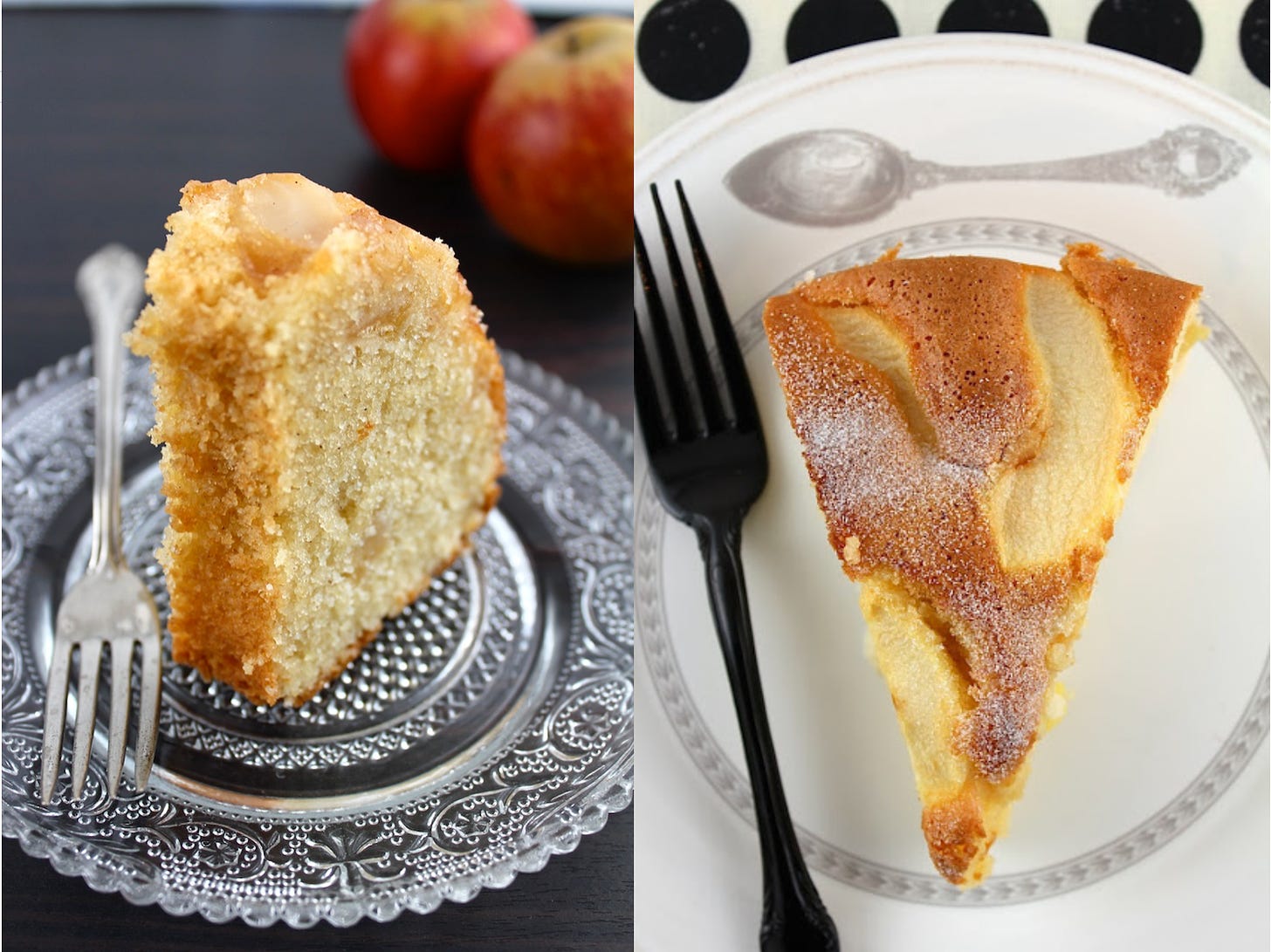

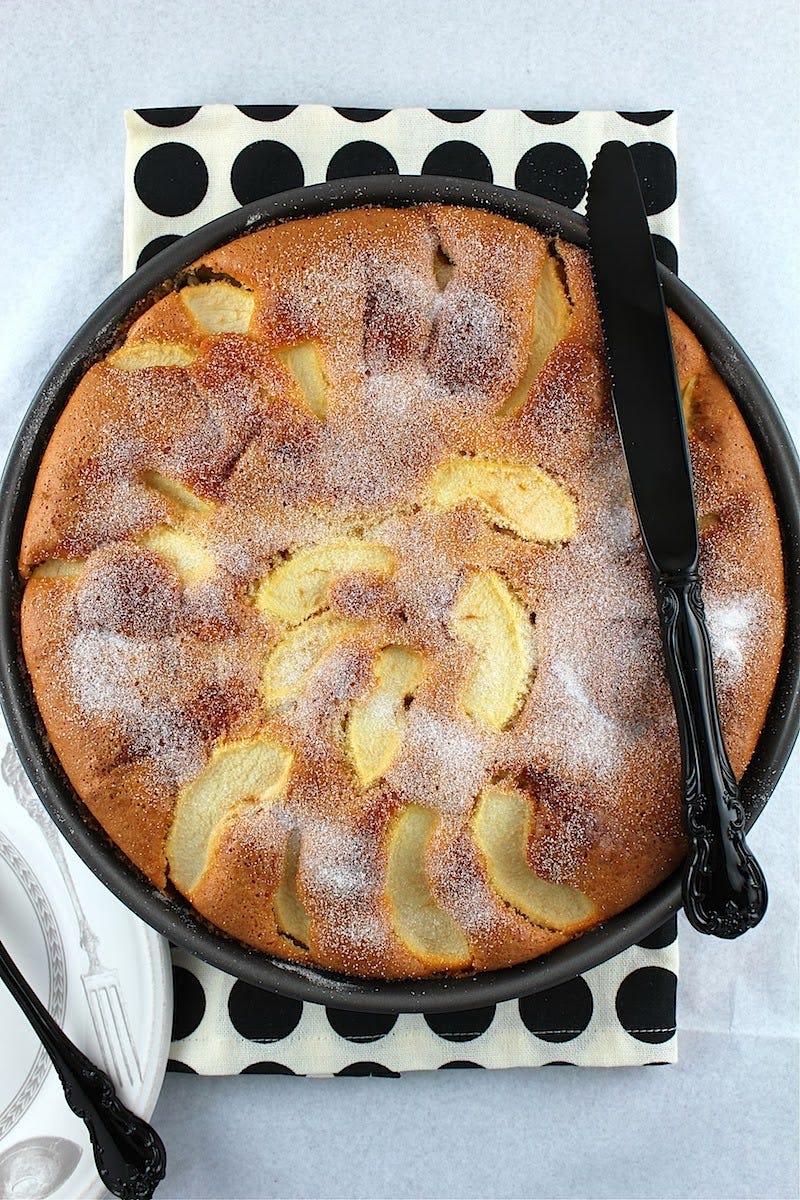
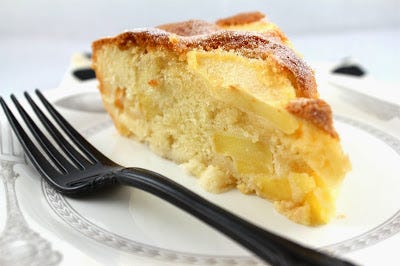
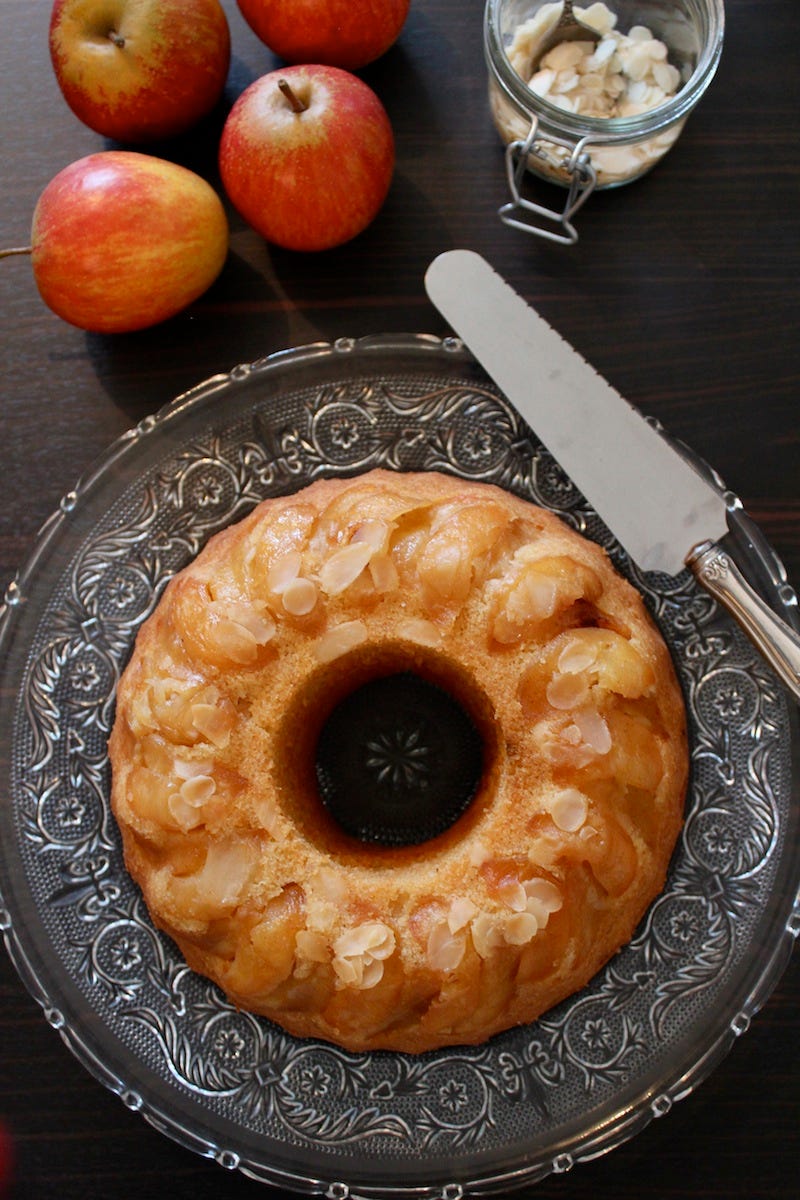
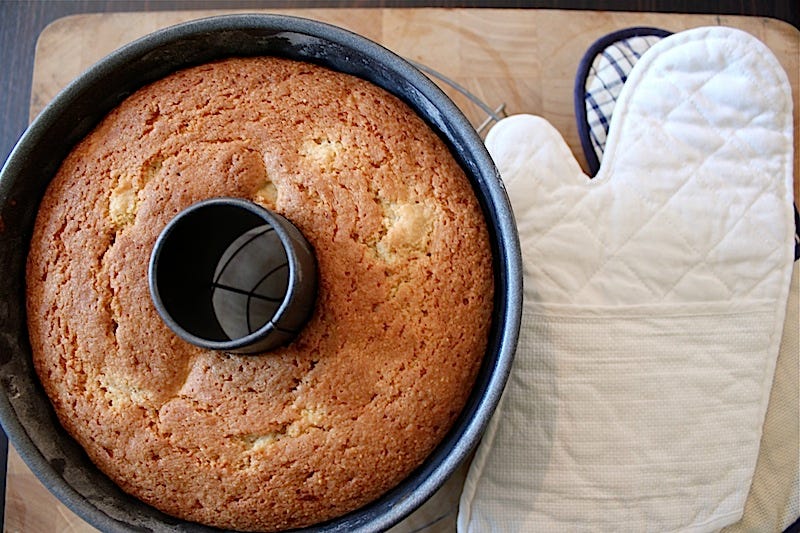
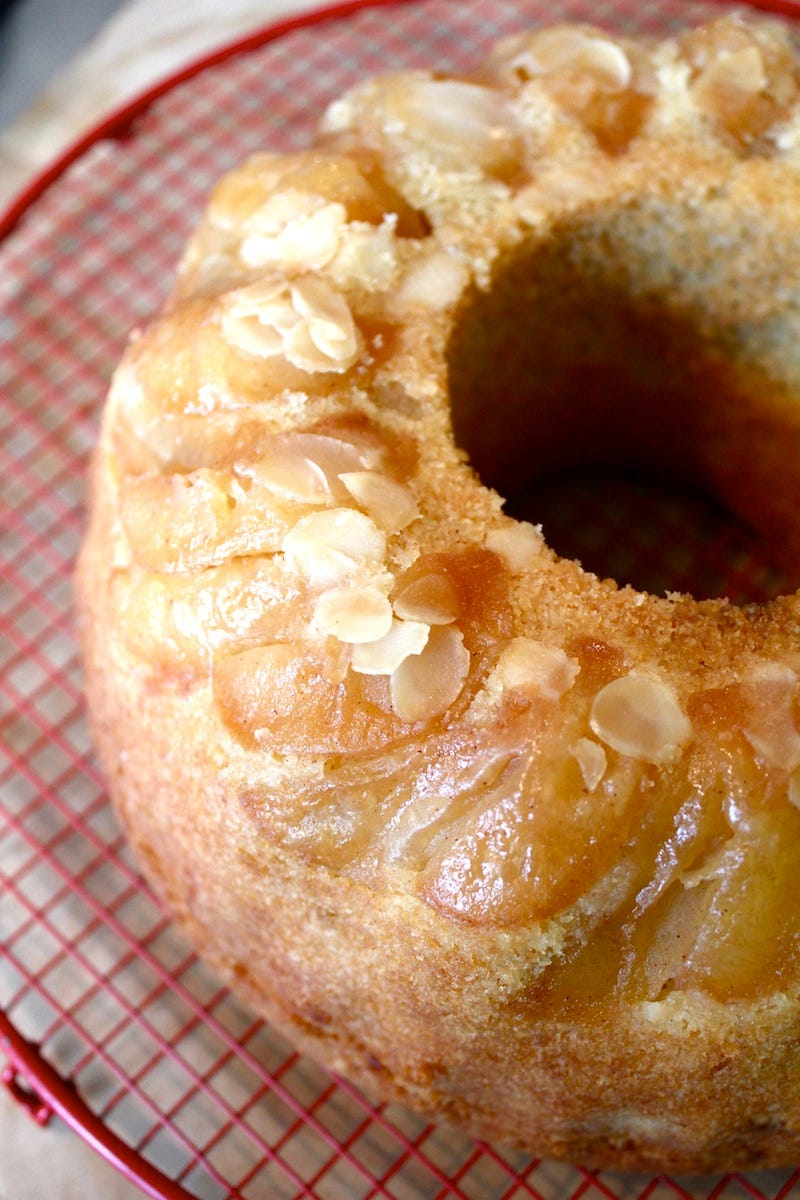

Yummy. Might make one of these for Thanksgiving, as my youngest & granddaughter do not like pumpkin pie. I was going to ask my youngest to make an apple pie, but these sound much better. Thanks, Jamie.
Jamie Do you ship to the states ? lol. I want to be shipped! Delishness